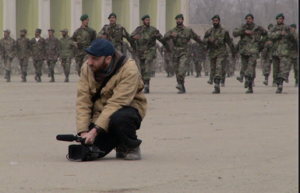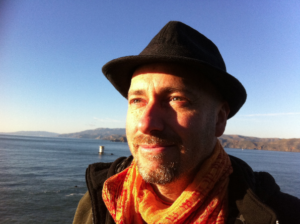
Occupy Love: an interview with Velcrow Ripper (2012)
Velcrow: “We are awakening from the false dream we have been relentlessly sold. A nightmare paradigm of a commodified world ensuring separation and scarcity. We are awakening to a new possibility, where the true abundance of this Earth is no longer hoarded. Where relationships are not transactions. Where your well being is my well being is the planet’s well being. That old dog-eat-dog story is a myth — collaboration is where it’s at. Co-operation has created the incredibly complex ecosystem called Earth that sustains and delights us. The competition aspect of evolution is for the juvenile species — it’s time we grew up and learned to share. From rainforests to coral reefs to human communities, we are inextricably intertwined in gorgeous webs of interdependence. This is what democracy looks like — planet to person to person to planet.”
Mike: You wrote the above missive hours after the brutal eviction of Occupy Wall Streeters from Liberty Square in NYC. I’m wondering if you could talk about the question of authorship in relation to the revolutionary interdependence you are describing. Is signing a work, or asserting individual ownership, a regressive hangover?
Velcrow: I have long been a lone wolf who celebrates the beauty of the team. I’m an auteur whose work proclaims the power of the collective through films that I write, shoot, direct, edit and sound design myself. It’s definitely a contradiction in my life. Of course I am not alone; I collaborate in the process, especially with my producers. I also publish my work on Youtube, often with a Creative Commons license, encouraging others to sample, remix and reflect in their own way. I engage closely with my audience through multiple test screenings, and these days I am also interwoven with the community through crowdfunding — there are 900 “community film producers” who are part of Occupy Love.
I believe it is a both/and scenario. Oneness does not mean sameness. As a sample from a favourite Robert Fripp album from years back proclaims: “We are resplendent in divergence.” For me the call of this era is: bring it on! We need all the fierce light we can muster. We need to bring our full individualism, with all its quirks and uniqueness, so that we can have the rich diversity we need to solve all the multiply converging crises of this moment.
We live in an era of personal branding. Everyone with a Facebook account is creating a projected image of themselves, contoured to their taste. Our digital fingerprint is most interesting when it is a reflection of our deepest selves, not simply parroting commodity culture. This can be healthy or simply narcissistic. I love the cartoon of Facebookers wandering the streets, holding pictures of themselves and asking, “Will you like my picture?” We can get lost in this hall of mirrors. In the end, it comes down to the ego. It always comes back to the ego. How do we navigate the hero’s journey (that we are all on) with selflessness? How can we find liberation from the constant rumble of the ego’s lament, trapped in perpetual insufficiency? At the same time, the path of individuation is a path of separation. If we dissolve into the ground of being — the emptiness that we truly are — there is bliss. Rumi calls love annihilation. Love is the annihilation of all that is false.
To be effective, a separate self and motivation is essential. Creating a powerful brand can be an act of compassion, or what the Buddhists call skillful means. I wish to expand my reach because I feel the best I can do in this era is to recognize and catalyze the heart of this movement. I can do that with a platform and social network, with a recognizable name and identity that people trust for its authenticity and artistry. So I sign my work.
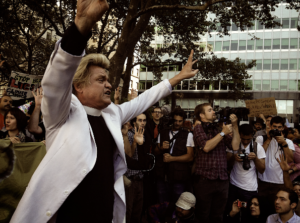
Mike: You were there for the first day of New York’s Zuccotti Park Occupy moment, it seems you have a knack for being at the right place at the right time, history is forever pulsing through your camera. Can you talk about why you went down and what you saw there?
Velcrow: I first heard about the plans to Occupy Wall Street on Facebook. Someone posted it on my wall, with the question, “Will you be there?” I’m part of a deeply connected community in the social media world, so I pay attention when suggestions are made. I followed the link and had the sense that this could be important. My last film, Fierce Light, begins and ends with the legend of a Mexican volcano known as the sleeping woman. The narration states that all over the world, people are waking up. The last line of the film is, “The sleeping woman is wide awake. Listen…” Well, at that time, in 2008, the sleeping woman was really still half asleep. Like many other activists, I was doing my best to encourage her to wake up.
For the next few years I began shooting a film called Evolve Love which asked the question “How could the climate crisis become a love story?” The answer that was emerging was related to the human response to the crisis — the way in which crisis is always a call to awake, to shake up the old paradigms. I could feel the rumblings of the volcano underfoot as I journeyed through the world shooting the film, and on January 25, 2011, with the eruption of the Arab Spring in Egypt, the sleeping woman was not just awake, she was roaring. Cornell West names this cry for justice “Love made public.”
On May 15, the spark jumped from the Middle East to Europe, with the beginning of the M15 movement, also known as the Indignados, which means “the Indignants.” Many in the movement eschew this media moniker, because the movement is much more positive and hopeful than indignant. It is equally “for” the new, as it is against the old paradigm. What is this new paradigm? At its heart, it is about a power shift away from the top-down, centralized and dominating culture, towards what is being called “horizontalism.” This is a power sharing model that recognizes our basic interdependence. My needs are not more important than yours, for we are one. This might sound a little flaky or new ageist, but it’s not. It’s fierce, it’s truth, it’s eminently practical, because the current exploitative model is destroying our economies and our communities. Greed is not sustainable, and it’s all so out of whack that at last people are waking up and creating something new for ourselves. We’re not waiting around for permission anymore.
On September 17th I responded to the call to Occupy Wall Street. The Vancouver-based magazine Adbusters made the initial call out, asking the question: is it time for our “Tahrir Moment?” They were referring to one of the first public spaces to be occupied during the Arab Spring, Tahrir Square in Egypt. It seemed like a stretch to me — activism in North America has been severely dampened ever since 9.11 and the possibility of recreating something as epic as Tahrir seemed highly unlikely. But I went. I gathered up my film gear, climbed on my bike and rode over the Brooklyn Bridge into the dank, concrete jungle that surrounds Wall Street and the former twin towers. I arrived at Zuccotti Park, a lifeless concrete plaza rarely blessed by sunlight. There were maybe a thousand people in the park when I arrived, and immediately I could sense something was different. These people weren’t protesting — they were sitting in circles throughout the park, rapt in discussion. Each group was developing proposals that they then brought to the larger body, the “General Assembly.” They were deciding for themselves what the issues were and what was important to them. Unlike the old forms of activism, there was no pre-determined campaign that would be enacted by the masses. People were figuring it out for themselves. It was participatory democracy in action, consensus-based and horizontal. It was “pre-figurative politics.” Rather than fighting for demands, this new movement, on the day of its birth, was pre-figuring the world it wanted to see. It was a model of what this new world would look like, how democracy could actually function.
On that afternoon, Zuccotti Park became a place where everyone was important because everyone had a voice. In the coming weeks this would deepen and grow astonishingly. In all my years of activism, I have never seen a movement flower with such spiritual maturity as this. For the first time there was a sense of wholeness; everything could be brought to the table, not just one specific part of a problem. The shared recognition that our difficult conditions are systemic brought people to the realization that the solutions must also be vast and systemic. As it emerged, Occupy Wall Street became a microcosm of a new world where everyone was fed, everyone pitched in, non-violent communication facilitators were always on hand, offering empathy and conflict resolution. Small scale permaculture was practiced, art and culture were celebrated and supported, meditation happened daily and was recognized as an important part of the movement. The homeless were given voice and diversity was celebrated, not tolerated. We were young and old, religiously affiliated and not, building strength and unity from our diversity.
Of course there were limitations — some argued the movement was too white — though that wasn’t my experience. I met many powerful people of colour deeply involved and committed to the movement. Shadow elements emerged, and there were problems because we have much healing to do, and these shadow plays took place in the camp, under the spotlight of media scrutiny. That’s okay, that’s a good thing. One of the undeniable accomplishments of Occupy is to make the invisible visible, particularly the suffering of the underclass because of the outrageous income disparity between most of us and the so-called 1% who are hoarding wealth and causing entire national economies to fail. Before Occupy, the conversation was about how to prop up Wall Street. Now it has shifted, dramatically.
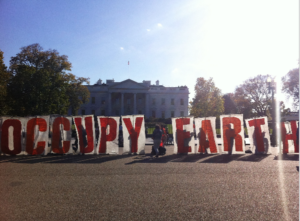
Mike: Can you describe your meeting with Lauren DiGioia, the young woman who unexpectedly took charge of Zucotti Park’s clean up?
Velcrow: In each of the revolutionary squares I have visited — from Occupy Wall Street, to Occupy Oakland, Occupy London, Puerto Del Sol and Placa Catalunya in Spain, and Tahrir Square in Egypt — I have been incredibly inspired by the new generation that is rising up and taking a stand, with a degree of spiritual maturity that I find rare in people twice their age. I am meeting youth in their early twenties who, without any prompting, talk of moving from a place of non-duality, recognizing the essential truth of non-separation, and committed to doing the hard work, both personally, and in community, to live that truth.
At Occupy Wall Street, I met a young woman name Lauren DiGioia, with a shock of dyed blonde and blue hair, tattoos of leaves falling down one arm, handing out vitamin C to the Occupiers. She heard the call to Occupy Wall Street, and joined the camp in the early days, becoming a committed, stalwart supporter. Like so many in this movement, this was her first experience of activism. She told me, “We are Occupying in the name of love — that’s the only thing that keeps us going. Because we are tired, we are exhausted, and without love, we would have given up long ago.” Word had just come down that the city was planning to evict us at dawn, claiming the park was unsanitary. They’ve been using that line since the eviction of Martin Luther King Jr’s Resurrection City, on the Mall in DC back in the sixties. It was clearly a ruse, but nonetheless, the call went out to clean up the park. Lauren was the head of sanitation, and this was her night. She gathered a huge squad of people with mops and buckets, and all night, in the pouring rain, we cleaned the park. She rallied the troops, standing atop the park tables to mic check words of encouragement. “Occupy with your bodies! Occupy with your hearts! Occupy with your spirits!” That morning, incredibly, the park filled with thousands of supporters, and the police backed down. It was the real beginning of the movement, and an enormous feeling of elation and possibility swept through us all. We were ecstatic.
Two months later, on the day the park was evicted, I found Lauren in tears. “They’ve ripped down everything we work so hard for. The movement isn’t gone, what we are fighting for isn’t gone, but our home is gone.” She showed me a new tattoo she had just got on the back of her neck: #OCCUPY. “This tattoo is as important to me today as it was when I got it last week. Because I will Occupy until the day I die.”
One young activist that day said to me, “You can evict the park, but you can’t evict our hearts. We can Occupy anywhere, anytime. We are Occupying this sidewalk right now.” As the signs that day read, “You can’t evict an idea.” What is that idea? When you boil it down, it always comes back to love. The systems that are destroying the planet are bereft of love. We need to re-invest a love ethic into all realms of our civilization. It’s the only way we are going to create a sustainable, thriving world that works for all life.
Mike: Fierce Light: When Spirit Meets Action (90 minutes 2008) is a travelogue of spiritual activism that finds you globetrotting in search of faith-based interventions. Can you talk about the pilgrimages you undertook?
Velcrow: I came to the slow cooking realization that my spirituality and activism had become so separated, it was almost a schizophrenia in my life, so I felt the need to bring them together. My films inevitably arise from inner journeys, and then I try to see how those echo something happening politically. When I talk about activism and spiritualism in the film, they aren’t presented as ideal forms. They can be present in the way we live our lives or how we relate to people. Many activists have had a negative experience with repressive religions, so they throw out religion and spirituality together. Spirituality for me isn’t something that happens in church on Sunday. It’s about how we move through our day, how present and open-hearted we are. Spirituality is distinct from religion. Religion often works against spiritual principles, for example, whenever it promotes hate, violence, fear, or a sense of separation. For me, spirituality must first and foremost be rooted in love.
One of my favorite definitions of spirituality — and there are many — is interconnectedness. This is the idea that everything in the universe is related to everything else; we are all part of each other. This is clearly understood today in the realm of science — for example, a forest is an intricate web of life, woven together by hundreds of miles of mycorrhizas. There is no separation. When we truly realize this on a personal level, it is a spiritual breakthrough, and can lead to a visceral sense of oneness with all of creation. When that awareness arrives, destroying the environment means destroying ourselves.
There are as many paths to spirituality as there are fingerprints. We fall into a trap when we think one size fits all. I looked for a diverse group of people because one of the movie’s core messages is a celebration of diversity. We need biodiversity in nature, and when you create monocultures — which is what corporations like Monsanto specialize in — you’re putting the whole system at risk.
So sure, I have icons like Daryl Hannah, but to me, that’s just skillful means. I mean, Hannah has a fear of heights and she put herself in a tree because she believed in the cause. Those are the moments that define the film because that is when people are putting spirit into action. I will confess my specialty is not interviewing the bad guys. There are people who do talk to the bad guys — but I’m not one of them. The people I want to focus on, and the people I’ve always been interested in, are the ones who are interested in making a positive change in the world.
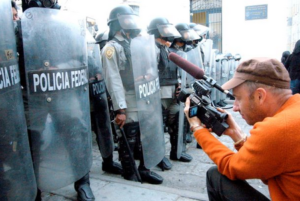
That’s why I put myself in the movie. All my movies are subjective. I make poetic essay documentaries. They are deeply personal and when you watch them with an audience, with the big sound and the big picture, everyone is moved. Fierce Light functions like a work of art. It gives you a deep, resonating experience.
Compassion is one of the greatest tools in our spiritual toolkit. With compassion, every conflict brings with it the opportunity for growth and transformation, instead of further polarization. Look into your adversary’s heart, not their ego, and you will find a vulnerable human being just like yourself. This goes for riot cops too. When we approach change-making so that our means are consistent with our ends, then we cannot lose. We’ve already won because we’re creating another world right now, not deferring it to the day we finally save this forest or that watershed. We are living the change, being the change. And the more of us who do that, the more that new world will become our shared reality.
Fierce Light is a feature-length documentary that takes us deep into the spiritual activisms exploding around the planet. Millions are discovering the power of taking positive, peaceful action that comes from the understanding that we’re all in this together. With this film, I came out of the closet as a spiritual person. Spiritual activism comes from a place of compassion, it’s based on what we are for, rather than what we are against. It’s what Ghandi called “soul force,” and what Martin Luther King called “love in action.” Fierce Light captures this inspiring zeitgeist, which is being called the largest global movement in history.
The American civil rights movement is a profound example of this — standing up with love in your heart in order to protest violence with non-violence. The powers that be didn’t know how to deal with this. The idea of responding to love and non-violence with violence was very unsettling. I thought I knew the story of the American Civil Rights movement, but it wasn’t until I actually set foot in the historic heartland of the movement — the front line cities of Selma, Birmingham and Montgomery, Alabama — and spoke to some of the surviving foot soldiers of the movement, that the true depths and power of this story arrived. What struck me most, was that this movement was rooted solidly in love. Not the Hallmark Card love that we have come to identify with the word, but a fierce love, a love of unrelenting compassion and unwavering nonviolence. A love that faces the bigotry and hatred of the Ku Klux Klan, and the police with their dogs trained on black dummies to attack wildly at the sight of black skin, and the many white citizens of the south who spit and taunted the protestors as they were beaten bloody for simply trying to sit at a lunch counter or ride a bus or cross a bridge. This love recognizes that behind hatred is hurt. Behind the anger and prejudice is fear. Behind the testosterone-fueled, male aggression of the hooded Klansman is a sad little boy who didn’t get enough love.
The people of the movement were fueled by faith, and though I’m not a Christian, and like many in this era of fundamentalism, have grown weary and wary of Christian rhetoric, I have developed a profound respect for the way Christianity informed the Civil Rights movement. It was sheltered in the churches, it was the one place they could safely meet free from interference in a segregated land. One of the churches we visited, the 16th St. Baptist Church, was firebombed by the KKK, resulting in the deaths of four young girls. This tragic act became one of the sparks that set off the irrepressible fire of the movement. The power of Faith, and Christ’s original teachings on justice and peace, gave great strength to the people as they surged forward in the face of systemic prejudice.
Reverend Calvin Woods, one of the foot soldiers of the movement, told me that non-violence was not just a tactic but a lived truth. They worked not only to stop themselves from striking back at the enemy, but learned to remove even the desire to strike back from their hearts. Reverend Mel White, who founded the movement “Soul Force,” talks of the love that Martin Luther King calls “Agape” and Gandhi called “Ahimsa.” It is a great love that embraces all beings, seeing all as a reflection of the divine, and that is profoundly non-violent. This is non-violence not just in deed, but in thought. Speech itself can be violent. Ask yourself before you speak or write a phrase: is this love speaking? Are you promoting biophilia, the love of life, or necrophilia, the love of death? As Martin Luther King said: hatred does not create love, only love can do that. Darkness cannot create light, only light can do that. How do you want to live your life?
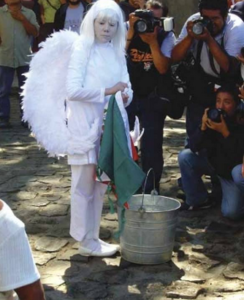
Mike: The 2006 murder of your friend and fellow media-activist Brad Will in Oaxaca, Mexico, figures as the touchstone for your quest narratives. Could you talk about Brad, and the footage you show in the film, the last shots he ever made?
Velcrow: I first met Brad during 9.11 in New York City, when I was shooting Scared Sacred. We were both doing coverage of the growing anti-war movement in NYC, which rallied under the banner “Our grief is not a cry to war.” We were part of the Indie Media Collective and we all crashed at their loft space in Manhattan. Brad was a “freegan” — he believed in living without money — and was an expert at it. At the end of each day he would collect sushi from a nearby restaurant and stock up the fridge. There we were — a bunch of broke, hungry, media activists living on free sushi!
Later I would run into Brad wherever large-scale, social change would happen. We were on the Zapatista caravan together as it wound its way through Mexico, at anti-globalization actions everywhere. The last time I saw Brad was at the World Social Forum in Venezuela. As always he gave me a big hug, and made me feel welcome and at ease. Activist scenes can sometimes be cliquey and elitist — who’s the most radical, who is the coolest — but Brad never bought into that. He was the essence of love in action. Brad was also a forerunner of the community garden movement and helped establish it in New York City, taking over vacant lots and transforming them into green spaces. Today there are over two hundred community gardens in the city. After Brad died we planted seeds in a vacant lot that he helped “liberate” — by chaining himself to a giant metal sunflower. The footage of that action is typical Brad — laughing and joking with the cops as they saw through the locks.
The film opens with the last footage Brad ever shot, images of paramilitaries in Oaxaca shooting at unarmed protestors. Brad stays with the action, diving under trucks and keeping his camera rolling. In the background you can hear someone shout, “Turn off that camera!” A few minutes later Brad is shot and the camera falls. He died not long after. To this day, justice has still not been done, and the killers walk free, protected by a veil of corruption.
Working with this footage, and watching it over and over again, was heartwrenching. When Brad died, I was struck by how easily that could have been me. Yet somehow I felt compelled to follow Brad’s footsteps down to Oaxaca to complete the story. I arrived three weeks later, in a city that was more dangerous for journalists than covering the Iraq War. I was scared, but I knew that I needed to be there.
The most biased coverage is to be found in the mainstream media. They are profit-motivated and corporate-dominated, which results in short story lines delivered without context, often violent in nature. How many times have I seen reports of “violent protestors,” when in fact the protestors are peaceful, and it is the police that are violent? Or, as is sadly often the case, there are a few agitators (often police infiltrators) or angry young men, who create the violence, and a whole movement gets tarred with an ugly brush.
My work has taken me into the shadow realms of humanity. Everywhere I have gone, even in the darkest zones of conflict, I have found people who are giving everything to try and create a world that works for everyone. Today I feel like we are on the cusp of a critical mass, where those of us who are dreamers and lovers are discovering that we are in fact the majority. We are being manipulated by a tiny percentage of the population who have a warped perception of human nature. We are waking up, it’s not too late, the time is now.
Mike: If Brad is the touchstone, the face of Fierce Light, then the community garden in south central Los Angeles feels like the heart of the matter. You visit so many people over the course of the film’s making, and gather moving testimonies from visionaries round the world, but this local struggle seems to root each of them. Can you speak about the garden’s evolution and what drew you there in the first place?
Velcrow: One day I got a call from Daryl Hannah, a fan of my earlier film Scared Sacred. She explained that she was sitting in a tree in a community garden called South Central Farms, that was on the verge of being destroyed by a developer. She was up in that tree with famed tree sitters Julia Butterfly and John Quigley. Something beautiful was happening, she said, and I should be there with my camera. Although Fierce Light had not received any funding, I could tell this was an important story and so I immediately rushed down from Canada to join the encampment.
Like many, I thought I would be there for a few days, but once I arrived, I was captured by the magic, and didn’t want to leave. The days of the “habitation” turned into beautiful weeks in which a new community was formed. The farmers came together in a brilliantly diverse human ecosystem that cut across lines of race, class and gender, drawn to the shining example that is South Central Farms. I am honoured to have experienced what is, at its essence, an outpouring of love — love for humanity, love for the planet, love for all that is sacred. South Central Farms offered a model that needs to be replicated everywhere, a model of restoration, of healing both the land and the human community, of urban sustainability, of possibility in a place where possibility is so rare.
One morning the police moved in and evicted the farmers. Our hearts were broken as the bulldozers ripped apart our garden. What I felt was not anger, but anguish. Slowly, with time, my anguish turned to empathy. Empathy for all the disappearing ecosystems of the world. Empathy for all the precious oases that are being destroyed by the crumbling old paradigm of the industrial growth society.
My sadness brought me back to a great loss in my life — the death of my brother, Randy, the year before, from cancer. I remembered the lessons of hope and love that were my brother’s parting gifts to his family. He taught us to never give up. Randy was determined to die at home, despite the doctors wanting to keep him in a sterile hospital, and together we succeeded in making that possible. He loved to sit in the backyard garden with a huge bucket of peanuts feeding the squirrels and birds. The garden was always filled with hummingbirds, jays, woodpeckers, you name it. He fed them, and they fed him. Even when he was no longer able to sit in his wheelchair, we could still wheel him out into his beloved garden on his hospital bed. He was out there the day before he died, wearing an inspirational t-shirt that I had sent him from India, years ago, when I was shooting Scared Sacred. It was the last shirt he wore. On the front it said, “Never Give Up,” and on the back was a quote from the Dalai Lama:
“Never give up
No matter what is going on
Never give up
Develop the heart
Too much energy in your country
Is spent developing the mind
Instead of the heart
Develop the heart
Be compassionate
Not just to your friends
But to everyone
Be compassionate
Work for peace
In your heart
And in the world
Work for peace
And I say again
Never give up
No matter what is going on around you
Never give up.”
(copyright©2003 His Holiness The Dalai Lama and Ron Whitehead
Message given by His Holiness The Dalai Lama to Ron Whitehead.
Longer message translated into this poem by Ron Whitehead.
Poem message blessed by His Holiness The Dalai Lama
with permission for Ron Whitehead to share with everyone.)
One day, in the wake of the destruction of the farm, I found Randy’s t-shirt, and I put it on, something I had never done before. I put it on and walked the few blocks to the community garden that grew in my own neighbourhood at the time, Strathcona Gardens in Vancouver, Canada. I walked through this intact oasis, past the lovingly tended garden plots, and I cried behind my sunglasses. I felt more determined than ever to dedicate my life to working towards a world that embraces the vision embodied by South Central Farms. Try as they might to crush us, we will rise, again and again, like the farm first rose from the fires of the L.A. Riots. The spirit of the people will prevail. Aqui estamos!
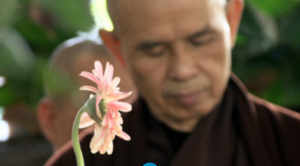
Mike: Scared Sacred (105 minutes 2004) is the first movie of your spiritual travelogue trilogy, setting up the inspirational activisms of Fierce Light and the global movements of Occupy Love. The first step finds you traveling towards sites of global catastrophe, from Bhopal’s Union Carbide disaster, Sarajevo’s civil war, and Hiroshima’s nuclear devastation. In each city you look for signs of the sacred, plunging into the aftermath of disaster to see how people have turned the impossible into a new kind of hope. Can you talk about why you set out on these harrowing journeys and what surprised you most?
Velcrow: I began Scared Sacred on the eve of the millennium. Like many in those days, I had a sense of impending doom. Even though I didn’t believe in the Christian view of the apocalypse, I felt that we were on the verge of a global crisis, and the millennium became a symbolic container for that fear. I chose to go straight into that fear, to do exactly the opposite of those survivalists who were digging holes and stocking up on food and water. I chose to travel into the darkness to see what I could learn from the ground zeros of the world. I wanted to face my fear. We all focus on the light where there is clarity, illumination and knowing, but darkness is the flip side, and there is deep wisdom to be found there, in that place of “not knowing.”
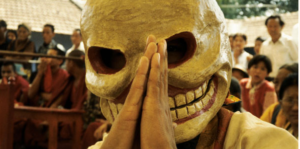
The first place we see in Scared Sacred is Bhopal, India, where eight thousand people died overnight in 1984 due to a leak at the Union Carbide chemical plant. Thousands more die every year from related diseases. I arrived after spending three months in an intensive Buddhist meditation retreat in south India. Imagine going from that into a toxic wasteland. I was overwhelmed, but then began to meet people and witness their awe-inspiring strength, which came from taking action. The community I met, especially the women survivors, blew me away. This is the biggest take away from Scared Sacred — that taking action is deeply healing and can become a source of meaning.
Activism is not simply marching in the streets. In Bosnia I met two artists who, during the four-year siege of Sarajevo, created art by collecting the debris of war and transforming it into sculptures. The only freedom they had was in their minds. This is what allowed them to survive.
In Hiroshima I discovered a poem by survivor Tamka Hari. “Lost in the shifting sand/in the midst of a crumbling world/the vision of one flower.” The film is not looking to turn bad things into good ones, but to bring attention to the single flower growing in the debris. In every place I found a local variant.
The biggest challenge was in Israel and Palestine. I wasn’t sure I’d find hope there because the divisions are so deep. I was shot at twice by the Israeli army when I was filming the construction of the Annexation wall that is being built around (and through) the Israeli-occupied territories. I had a phantom sensation of a bullet entering my back. Afterwards there was laughter and a sense of release. It was both funny and sad because I saw how vulnerable I was. While I ran from the barrier being erected by Israel, I asked myself, “What if my child was shot? Would I want to strap a bomb to my body and take revenge?”
As if in answer to this question, I met a group called the Parents Circle-Families Forum. It is comprised of both Israelis and Palestinians whose children have been killed in the conflict. One of their projects is called “Hello Peace,” where any Palestinian or Israeli can phone 611 and be connected to the other side just to talk. They’ve had 300,000 calls in three years.
Humour is also an important tool of survival when things go wrong. In the film, there are a few times when the joke’s on me. At the place where the Buddha attained enlightenment, I meditated under the Bodhi tree, but when I came back my shoes were gone. I had to walk to my room barefoot. People probably thought I was a westerner ritually shedding material goods. My camera, car, and other possessions were stolen at regular intervals during these travels. Perhaps these were lessons in letting go!
I’m an explorer. That’s my job description. The independent investigation of truth is a key tenet of the Bahá’í faith and this has guided my documentary films, even though I left the faith at sixteen to find things out for myself. My purpose as a communicator is to gather stories and pass them on. It is a responsibility.
Everywhere I went I used the Tibetan Buddhist visualization practice of Tonglen meditation. I would have been overwhelmed without it. In Tonglen you breathe in suffering, transform it, and release it as compassion. It helped me stay open to whatever was present without becoming numb, or paralyzed with hopelessness. In New York City, during 9.11, I practiced Tonglen in front of Ground Zero, where the smoke was still rising. I realized I was breathing in particles of the dead, like all New Yorkers in those days. Suddenly the practice became quite literal.
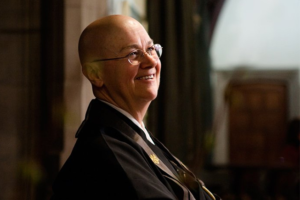
In New York I met Roshi Pat Enkyo O’Hara, co-director of the Zen Peacemakers located just a few blocks from Ground Zero. She told me, “If ordinary human beings in the world can see their own suffering and feel their own vulnerability, then perhaps they can become aware of the vulnerability and suffering of others. That’s what going to a sacred place — going to a place where great suffering has happened — is about. It means opening yourself completely, and acknowledging it, and not blocking it. That’s the transformative moment, when you begin to see that you’re not separate from any of the people involved — perpetrators and victims. And then change can happen. That’s why people need to go to Hiroshima, and Nagasaki, they need to go to Cambodia. And now, here.”
By the end of the Scared Sacred journey, I’d become a very different person. I developed a core sense of strength and increased sensitivity without being a feather in the wind. My sense of boundary and isolation has lifted. I’m left with an ability to see each face as my own. I have a relentless sense of hope. It’s an inspiring force.
